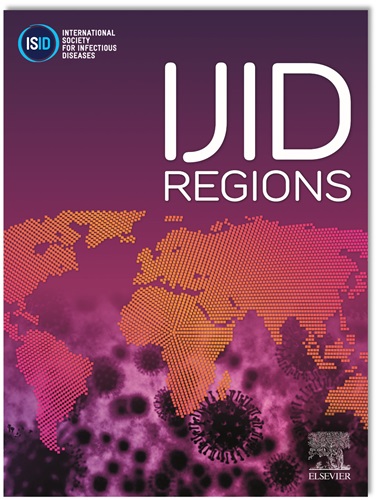A comparative analysis of the impact of climate change on emergence of infectious diseases and outbreaks in remote areas of Sindh, Pakistan
IF 4.8
2区 医学
Q1 INFECTIOUS DISEASES
引用次数: 0
Abstract
Introduction
Remote areas in the Sindh province of Pakistan are characterized by challenging terrain, limited access to healthcare, and poor infrastructure. These regions often face a higher burden of infectious diseases due to the lack of proper healthcare facilities. Diagnostic surveillance plays a crucial role in monitoring disease prevalence since it enables early detection, timely intervention, and developing effective public health strategies. Among other factors, climate change also influences disease distribution and severely impacts the incidence of several illnesses. For instance, recent flooding in Sindh caused a surge in waterborne diseases, due to contaminated water sources and inadequate sanitation that act as breeding grounds for pathogens. Comparative analysis of disease surveillance pre- and post-floods can help in understanding the changes in disease dynamics which are instrumental in refining public health strategies and optimizing resource allocation in the face of environmental challenges. This study was designed to compare and analyze disease distribution before and after the 2022 floods in remote areas of Sindh, Pakistan. By comparing the two time periods, the study aimed to identify seasonal trends for infectious diseases to design effective strategies that minimize transmission rates and reduce healthcare burden.
Methods
To access the rough terrain in the remote areas of Sindh, a USAID funded, fully-equipped BSL-2 mobile laboratory with a team of microbiologists from the Provincial Public Health Laboratory, Dow University of Health Sciences visited Ratodero, Aarija Taluka, Kambar, Nasirabad, Dokery, Sukkur, and Gadap. This study happened in two phases, before and after the 2022 floods. Diagnostic tests for HIV, malaria, hepatitis B, hepatitis C, typhoid, and COVID-19 antibody were performed, along with complete blood count.
Results
A total of 2858 tests were performed out of which 56% were males and 44% females. During phase I (pre-floods), 5.2% had malaria, 1.9% had HCV, and 12% were positive for COVID-19 antibody. During phase II (post-floods), 46.6% were positive for malaria, 31.7% for COVID-19 antibody, 9.2% for HCV, 8% COVID-19 antigen, and few cases of HIV, hepatitis B, and typhoid were also detected.
Discussion
This study highlights the pressing health challenges faced by remote areas in Sindh, Pakistan, exacerbated by climate change-induced events like floods. The comparative analysis of disease distribution before and after the 2022 floods underscores the vulnerability of these regions to infectious diseases like malaria and COVID-19.
Conclusion
Climate change poses a significant threat to low-income countries, especially remote areas, worsening the already considerable disease burden they face. Routine monitoring and surveillance of disease prevalence is crucial to create targeted interventions that bridge the gap in these vulnerable regions and lessen the burden on the healthcare systems.
气候变化对巴基斯坦信德省偏远地区传染病出现和疫情影响的比较分析
巴基斯坦信德省偏远地区的特点是地形复杂,获得医疗保健的机会有限,基础设施落后。由于缺乏适当的卫生保健设施,这些地区往往面临较高的传染病负担。诊断监测在监测疾病流行方面发挥着至关重要的作用,因为它能够早期发现、及时干预和制定有效的公共卫生战略。除其他因素外,气候变化还影响疾病分布,并严重影响几种疾病的发病率。例如,信德省最近的洪水导致水传播疾病激增,原因是水源受到污染,卫生设施不足,成为病原体的滋生地。洪水前后疾病监测的比较分析有助于了解疾病动态的变化,这有助于在面临环境挑战时改进公共卫生战略和优化资源分配。本研究旨在比较和分析2022年巴基斯坦信德省偏远地区洪水前后的疾病分布。通过比较这两个时间段,该研究旨在确定传染病的季节性趋势,以设计有效的策略,将传播率降至最低,减轻医疗负担。方法为了进入信德省偏远地区的崎岖地形,美国国际开发署资助的一个设备齐全的生物安全二级移动实验室与来自道卫生科学大学省公共卫生实验室的微生物学家团队访问了Ratodero、Aarija Taluka、Kambar、Nasirabad、Dokery、Sukkur和Gadap。这项研究分两个阶段进行,分别是2022年洪水之前和之后。进行了艾滋病毒、疟疾、乙型肝炎、丙型肝炎、伤寒和COVID-19抗体的诊断检测,并进行了全血细胞计数。结果共检测2858例,其中男性56%,女性44%。在第一阶段(洪水前),5.2%的人患有疟疾,1.9%的人患有丙型肝炎病毒,12%的人患有COVID-19抗体。二期(灾后)疟疾阳性率为46.6%,COVID-19抗体阳性率为31.7%,HCV阳性率为9.2%,COVID-19抗原阳性率为8%,HIV、乙型肝炎和伤寒阳性率也较低。这项研究强调了巴基斯坦信德省偏远地区面临的紧迫的卫生挑战,而洪水等气候变化引发的事件加剧了这一挑战。对2022年洪涝前后疾病分布的对比分析凸显了这些地区对疟疾和COVID-19等传染病的脆弱性。气候变化对低收入国家,特别是偏远地区构成了重大威胁,加剧了它们本已相当沉重的疾病负担。对疾病流行情况的常规监测和监测对于制定有针对性的干预措施、弥合这些脆弱地区的差距和减轻卫生保健系统的负担至关重要。
本文章由计算机程序翻译,如有差异,请以英文原文为准。
求助全文
约1分钟内获得全文
求助全文
来源期刊
CiteScore
18.90
自引率
2.40%
发文量
1020
审稿时长
30 days
期刊介绍:
International Journal of Infectious Diseases (IJID)
Publisher: International Society for Infectious Diseases
Publication Frequency: Monthly
Type: Peer-reviewed, Open Access
Scope:
Publishes original clinical and laboratory-based research.
Reports clinical trials, reviews, and some case reports.
Focuses on epidemiology, clinical diagnosis, treatment, and control of infectious diseases.
Emphasizes diseases common in under-resourced countries.

 求助内容:
求助内容: 应助结果提醒方式:
应助结果提醒方式:


